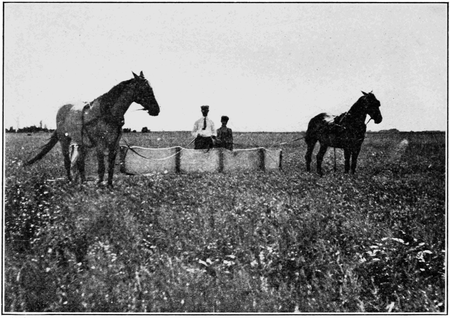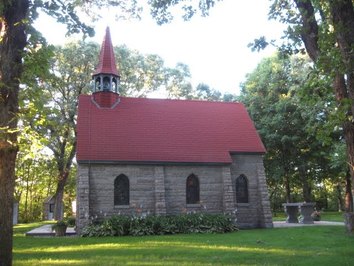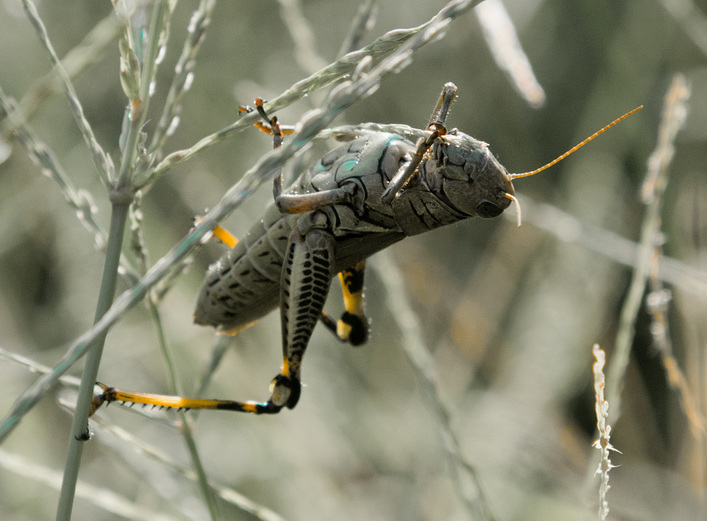|
Work never ended for settlers in the late 1800's. They fought to claim the land. Looking at a tree-filled plot, they imagined a blank canvas they could fill with full-grown crops, planted in straight lines packed to the horizon. It was optimism to see it in that landscape. They cleared it, planted and cared for the crops, and built their dreams upon the land. Their optimism was tested in 1873 when Rocky Mountain locusts descended upon Minnesota fields. Commonly called grasshoppers or hoppers, with their first appearance they devastated crops. In Mary Vance Carney's book, "Minnesota, The Star of the North," the old farmers later recalled the locusts' arrival, saying, "Sunlight, shining on the outspread wings of the insects as they flew through the air, made the swarm look like a white cloud."  Just as our family's McLeod County ancestors must have done, with hope, Minnesota farmers replanted after the first year's crop devastation, but the legacy of the previous year were the eggs of locusts that would emerge to devastate their crops again. Rangeland's April 2000 article, "The Past, Present, and Future of Rangeland Grasshopper Management," said farmers tried any number of remedies for the locusts including fire and arsenic. Finally, out of necessity, 'The Hopperdozer' was created. It was simple but effective. It was a piece of sheet metal formed so that it could be dragged by horses through the fields with tar smeared onto the front of the metal sheet. As it was hauled through the fields, the locusts would fly up to avoid it and be trapped in the tar. Workers would then clear the locusts from the metal plate, tar the sheet again, and the horses would continue through the fields. Mary Vance Carney said many fields were saved by 'The Hopperdozer'. According to Alpheus Spring Packard, the locusts cost the state $8 million during the four summers ending in 1876. By 1877, the locusts had devastated over 5 million bushels of wheat in Minnesota, and the legislature, realizing locusts were the primary threat to the state, voted to suspend the farmland tax payments for the period of the locust plagues for up to 160 acres of land per farmer. They also established a bounty for grasshopper eggs. One dollar per bushel of grasshoppers if caught before May 25, fifty cents between then and June 10, twenty-five cents until July 1, and twenty cents until October 1. Men Could avoid the Grasshopper draft if they paid one dollar for the day missed. However, if they failed to report to grasshopper duty without paying the penalty, they were charged with a misdemeanor.  In affected counties, men aged 21 through 60 were required to work one day per week during the month of May to eliminate the grasshoppers. They In affected counties, men aged 21 through 60 were required to work one day per week during the month of May to eliminate the grasshoppers. They could avoid the draft if they paid one dollar for the day missed. However, if they failed to report to grasshopper duty without paying the penalty, they were charged with a misdemeanor which carried a fine up to ten dollars or ten days in jail. Minnesota Governor John Pillsbury took the unusual step of setting a special day aside, April 26, 1877 as a day of prayer to alleviate the destruction by the hoppers. There are many stories that on the day of prayer a sudden late spring snowstorm covered the locust eggs with ice, killing them. There is evidence of .25-inch snow, sleet, and rain referenced in local papers. There is even a Grasshopper Chapel built in Cold Spring, Minnesota in thanksgiving for deliverance from the locusts. Finally, during the summer of 1878, the hoppers emerged from their eggs, but this time, just as they had arrived four years earlier, they left in mass, a white cloud, to devastate other fields. Photo courtesy Creative Commons at: Locust, by TVNewsBadge Hopperdozer Grasshopper Chapel, by Glenn M. Harden Sources: Minnesota: The Star of the North, Mary Vance Carney, 1918 Rangeland: The Past, Present, and Future of Rangeland Grasshopper Management, Kerri M. Skinner, April 2000 Assumption Chapel, Wikipedia Report on the Rocky Mountain Locust and Other Insects Now Injuring or Likely to Injure Field and Garden Crops in the Western States and Territories, Alpheus Spring Packard, 1877
0 Comments
Your comment will be posted after it is approved.
Leave a Reply. |
Gail WawrzyniakGail Wawrzyniak is a North Carolina writer bringing together her love of art, history and writing. Archives
October 2017
Categories
All
|

 RSS Feed
RSS Feed